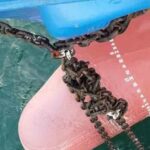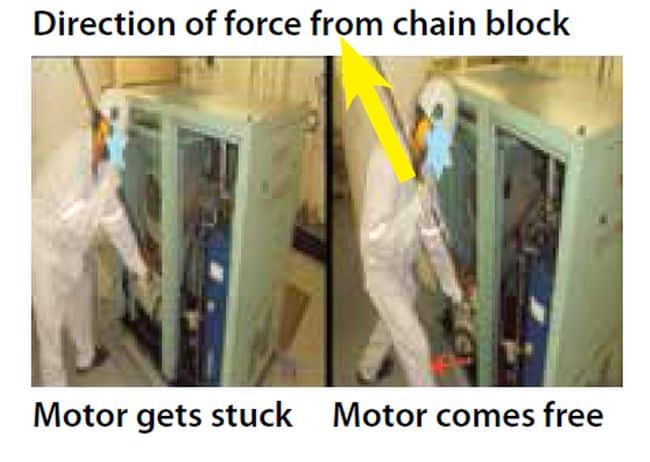Real Incident On Ship: Oil Cargo Spill From Tank Washing Line Drain Cock
During a ballast voyage, a product tanker completed tank cleaning operations for change of cargo grade. Her next loading port was in North America, and in anticipation of freezing winter conditions, all fresh and sea water lines on deck, including the tank cleaning lines drains, were left open as a precaution. The supply valves of the individual tank cleaning machines were ordered shut. The ship loaded a full cargo of diesel oil and sailed. After disembarking the sea pilot at about midnight, the vessel began rolling to a moderate beam swell.
By daybreak, the Chief Officer (C/O) on bridge watch noticed a small pool of oil cargo moving with the roll on the main deck starboard side, between the deck longitudinal and ship’s side. The Master was immediately called and the oil spill emergency response plan was activated. Upon the Master’s arrival on the bridge, the C/O proceeded to the main deck. Meanwhile, the crew had plugged all the scuppers on the main deck.
The crew found that cargo was coming out through the open drain cock on the tank cleaning line branch to 5 Starboard Cargo Oil Tank (COT). This valve was immediately shut, and the deck team then discovered that the supply valve for 5S. Tank Cleaning machine was also partially open. The supply valve was then also closed tight. Although no oil or sheen was visible in the ship’s wake, it is possible that some oil could have escaped to the sea during the hours of darkness.
Immediate actions taken
- Clean up operations were commenced and the spilled cargo mixed with water (estimated 500 litres) was transferred to the slop port tank by portable pump;
- The incident was reported to the office;
- The Qualified Individual (QI) was notified as required by Vessel Response Plan, who, in turn, reported the incident to USCG;
- Alcohol testing of all staff was conducted and negative results recorded;
- All tank-cleaning lines, valves and drains were confirmed shut.
Root cause/contributory factors
- Faulty design: The supply valve for 5S tank cleaning machine was found partially open despite the order for all valves to be closed. All these valves were fitted with long operating handles very near deck level which could easily get in the way of a person walking past. During the final stages of loading, many ship and shore personnel were on deck in the vicinity of this valve handle as the tank was gauged and sampled. It is possible that anyone, particularly a shore person, could have accidentally kicked the valve handle and opened it without knowing the consequences;
- Crew negligence: All tank cleaning line valves in this vessel are designed to accommodate a locking arrangement but many locking pins were missing and therefore the valves could not be positively secured in closed position;
- The drain cock of the tank cleaning line was kept open as a precaution against freezing. This resulted in only a single valve barrier between cargo tank and the environment, which presented an unacceptable pollution risk;
- With the near-full loaded condition, the tank cleaning machines were submerged in the cargo. The increase in vapour pressure inside the tank due to cargo sloshing resulted in the cargo being pushed up into the tank cleaning line. The cargo then passed through the partially opened tank cleaning valve and fully opened drain valve on to the deck, resulting in the oil cargo spilling on deck;
- The Company’s pre-loading checklist does not specifically require the closing of the tank cleaning line and associated drain valves.
Corrective/preventative actions
- A safety meeting was conducted by the marine superintendent at the next port and the incident was discussed in detail;
- Crew re-trained on proper post tank-cleaning/pre-loading procedures;
- Pre-loading check list has been amended to include the closing of all tank cleaning line valves, drain cocks/caps;
- Missing locking pins on all valve handles have been renewed;
- Placards have been posted near all tank cleaning and line drain valves to ensure they are closed prior to any cargo operation;
- Chief Officer’s standing instructions have been amended to ensure that all drain valves are positively shut after tank cleaning operations;
- Incident made part of pre-boarding briefing for all officers.
Lessons learnt
- As a routine, a two-man team must regularly ensure that all deck valves not actually required for a cargo tank operation are secured shut;
- Risk of pollution exists even when vessels are safely navigating in the open sea.
Reference: nautinst.org
Do you have info to share with us ? Suggest a correction
- Real Life Incident: Vessel Collision in Good Visibility
- Real Life Incident: Severe Injury To Deck Crew While Leaving Berth
- Real Life Incident: Departure Damage in Very Restricted Waterway
- Real Life Incident: Low Situational Awareness Has High Impact Consequence
- Real Life Incident: Fouled Anchor in a Designated Anchorage
- Real Life Incident: Fire On Barge Carrying Scrap Metal Causes $7 Million Worth Of Damage
Latest Case studies Articles You Would Like:
Subscribe To Our Newsletters
By subscribing, you agree to our Privacy Policy and may receive occasional deal communications; you can unsubscribe anytime.
Web Stories
























